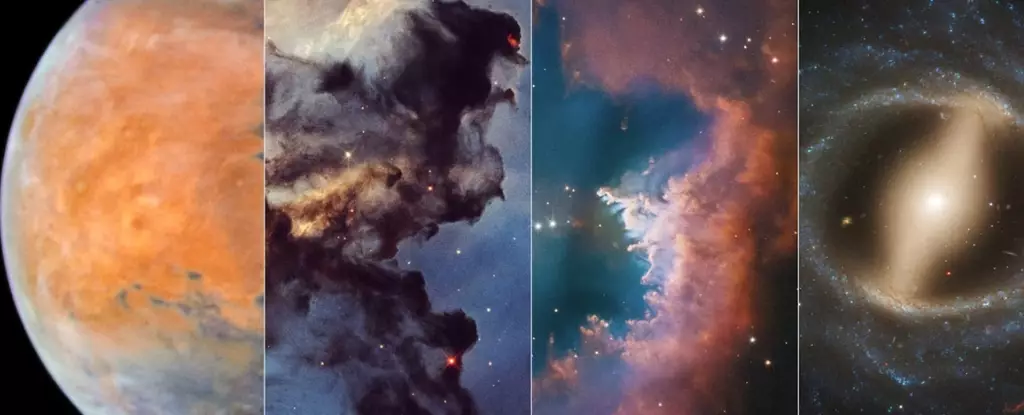This week marks a monumental occasion—the 35th anniversary of the Hubble Space Telescope’s launch into the cosmos. Rather than receiving gifts, the brilliant minds behind Hubble are giving back, unveiling four stunning new images that showcase the elegance and complexity of the universe. From haunting glimpses of Mars to enchanting views of celestial galaxies, these images highlight the telescope’s unparalleled contribution to our understanding of the cosmos. This anniversary serves not just as a celebration of Hubble’s history but also a reflection on how it has transformed our perception of the universe since its deployment aboard the space shuttle Discovery on April 24, 1990.
Hubble hasn’t just been a tool of scientific inquiry; it symbolizes humanity’s enduring quest for knowledge. As Shawn Domagal-Goldman, NASA’s acting director of the Astrophysics Division, articulated, Hubble opened an invaluable window to the universe. The implications of this groundbreaking instrument have rippled through the scientific community, providing profound insights that shape future exploratory missions like the Habitable Worlds Observatory.
Overcoming Challenges: A Testament to Human Ingenuity
While the telescope now stands as a beacon of success, its journey was not without obstacles. Upon its deployment, scientists were devastated to discover a significant flaw in Hubble’s primary mirror. However, rather than yielding to frustration, the scientific community rallied to support Hubble. In a remarkable display of human ingenuity, astronauts conducted a servicing mission in 1993, implementing crucial hardware that vastly improved image sharpness. This pivotal moment marked the dawn of a new era for astronomy and set the stage for future discoveries about exoplanets, black holes, and the very fabric of the universe.
Hubble’s initial shortcomings underscore the unpredictability of space exploration. Yet the experience gleaned from its numerous challenges paved the way for modern missions, reminding us that resilience is fundamental to scientific advancement. Hubble didn’t just evolve; it transformed the methods and expectations associated with astronomical observation.
Images that Ignite the Imagination
In celebration of this milestone, the images revealed are nothing short of breathtaking. Captured late last December, the images of Mars reveal striking geological features, showcasing ice caps and dormant volcanoes. Observing celestial bodies like Mars provides not only visual splendor but also feeds our curiosity about the potential for life beyond Earth. Similarly, the images from the Rosette Nebula allow us a glimpse into stellar birthplaces located 5,200 light-years away. The visual narrative these images create captivates both scientists and the public alike, nurturing an ongoing appreciation for the wonders of the universe.
The astonishing visuals also include the planetary nebula NGC 2899, likened to the fluttering wings of a moth, illustrating the intricate processes shaping the cosmos. It is a reminder that amid the chaos and scale of space, beauty thrives within the scientific journey. Consequently, Hubble’s remarkable capabilities are more than observational; they are artistic expressions that compel our imaginations and ignite a passion for exploration.
Exceeding Expectations and Future Ventures
Over its operational life, Hubble has conducted nearly 1.7 million observations, focusing on approximately 55,000 targets and contributing to over 22,000 research papers. Such vast engagement with the cosmos demonstrates the telescope’s value in expanding human knowledge. Nevertheless, the loss of the space shuttle Columbia in 2003 raised significant concerns regarding Hubble’s future. The community’s passionate outcry underscored Hubble’s importance, resulting in a final servicing mission in 2009 that resurfaced optimism for its contributions. Rather than gradually approaching obsolescence, Hubble has defied its lifespan expectations, celebrating an additional 16 years of fruitful exploration post-repair.
As Hubble expertly navigates the cosmos, the scientific spotlight has shifted towards the next generation of space telescopes, notably the James Webb Space Telescope (JWST), which promises to build upon Hubble’s iconic legacy. With its superior light-gathering capabilities and dedication to infrared observations, JWST opens another chapter in unraveling the mysteries of the universe. Despite its advancements, however, it lacks Hubble’s flexibility for optimal observations across various wavelengths and cannot be serviced in orbit like its predecessor. This finitude highlights the crucial role of Hubble in the broader narrative of astronomical discovery.
A Glimmer of Hope: The Habitable Worlds Observatory
Looking ahead, NASA has ambitious plans for the Habitable Worlds Observatory (HWO), intended to examine potential Earth-like planets orbiting distant stars. Unlike JWST, which largely focuses on infrared, HWO will observe in visible and ultraviolet light, promising even sharper images than those produced by Hubble. This new mission aims to further delineate the attributes of habitable environments beyond our solar system, forging pathways to understanding life as we know it.
In an age where the thirst for knowledge continues to expand, the legacy of Hubble is a harbinger of hope and discovery. Its evolution from a flawed telescope to an astronomical marvel demonstrates that every challenge can yield extraordinary developments. As we celebrate 35 years of Hubble, we remain resolute in our quest to explore the cosmos, guided by its pioneering spirit and enriched by its invaluable lessons.


Leave a Reply